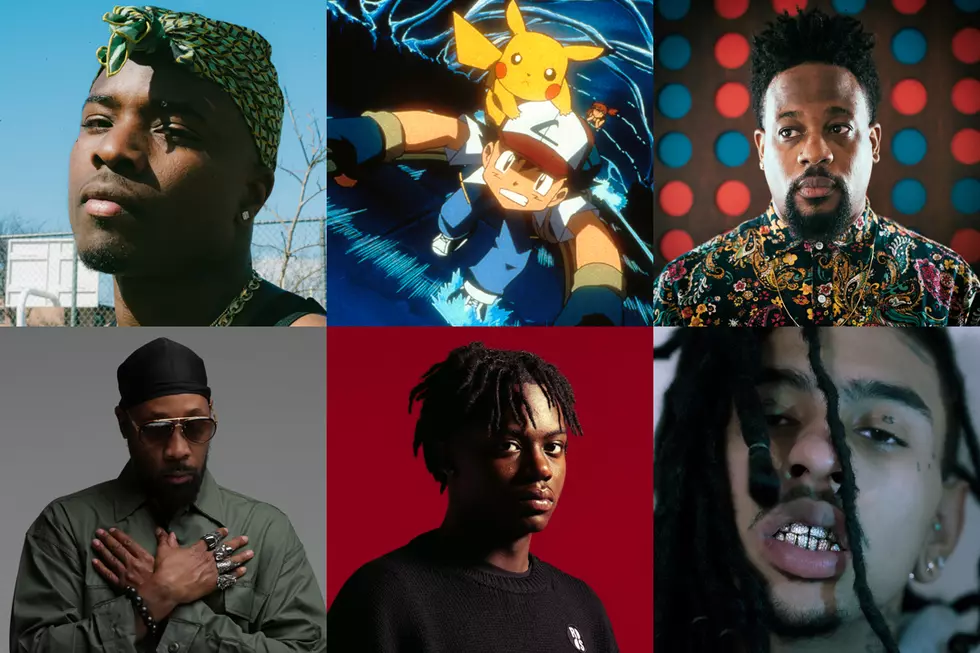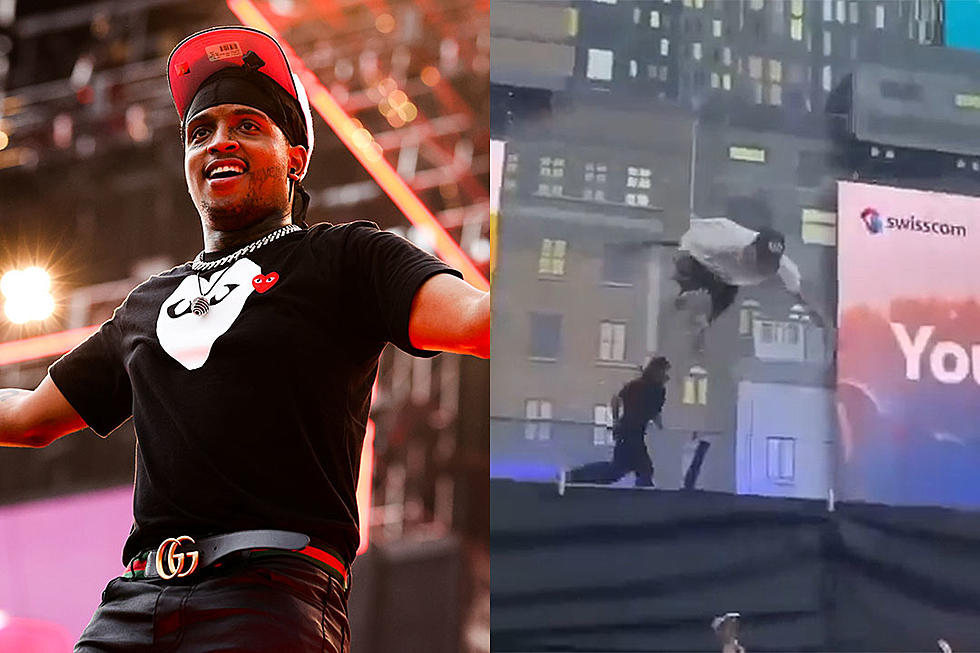
RZA, SSGKobe, Idk, Robb Banks and Open Mike Eagle Explore Hip-Hop’s Connection to Anime
Geekin'
Anime fandom was once relegated to nerds and the uncool crowd, but it's since become a way of life for rappers both in and out of music.
Words: Peter A. Berry
Editor’s Note: This story originally appeared in the Fall 2022 issue of XXL Magazine, on stands now.
A tour de force of geekdom was unleashed by Cochise this past summer when he turned his 2022 XXL Freshman freestyle into an anime lover’s dream. Sitting on a throne surrounded by statues, he let loose a barrage of cheeky wordplay at the intersection of shinobi fantasy and URL battle raps: “To be honest, my life got better when I was fired/I been in the rain, feelin’ pain and I ain’t talkin’ ’bout Jiraiya/Went to the jeweler, now the earpiece heavy/Pole hit his back, now he look like Neji.” Fans’ reception was overwhelmingly positive in the YouTube comments section for his nods to the Naruto characters Jiraiya and Neji.
Depending on a listener’s childhood pastimes and TV time, the name-drops either inspire a quick Google search or nostalgic bliss. For someone like Cochise, a longtime fan of the iconic anime, it would be the latter. The Florida artist is just one part of an ongoing, growing collection of hip-hop artists that extract inspiration from anime, which is a style of Japanese television animation. Comprising richly adventurous storylines, kaleidoscopic characters and even more colorful artwork, the inimitable genre has become one of Japan’s most famous exports. While anime fandom was once seen as an undertaking for nerds and dwellers of a clandestine geek underground, it’s since become a form of entertainment for folks across the rap spectrum. It shows in their music, too.
But this trend isn’t completely new; it just continues to grow. As far back as 2005, Lupe Fiasco used an electric guest spot on Kanye West’s “Touch The Sky” to name-drop acclaimed 1970’s anime Lupin the 3rd. On his 2016 single, “Wat’s Wrong,” Isaiah Rashad referenced Kaio-ken, a Dragon Ball Z martial arts technique. The cover art for Ugly God’s 2016 single “Water” features the titular creatures from Pokémon. In 2018, Lil Uzi Vert sampled the title song of the anime Death Parade for his own track “New Patek.”
For some rappers, anime’s attraction rests in aesthetics. Others point to life lessons or the story structures. Sometimes, it comes down to a feeling. “It can literally take you into a different world,” says rap newcomer SSGKobe, whose name is a portmanteau of Super Saiyan God—a transformation found in Dragon Ball Z. “You can be outside of your normal boundaries. It was like an escape for me.” Sword Art Online, Bleach and Death Note are among his favorite anime. Rapper IDK echoes SSGKobe’s sentiment: “It was the feeling that I felt like escaping the current world that I was in and being able to put myself somewhere else.”
Chicago artist Open Mike Eagle, whose 2020 album, Anime, Trauma and Divorce, was inspired by anime he watched while dealing with depression, points to anime’s artistic details as being one of the first elements that grabbed his attention. As he grew older, however, he began to notice a spiritual connection.
“I think power fantasies really resonate in the hood,” says Mike. “A lot of [anime] starts out with people who are downtrodden or beat down by life. If you look at Goku in Dragon Ball, Deku [nickname for Izuku Midoriya] in My Hero Academia, these are people who’ve been dealt a bad hand, and there’s something really compelling and inspiring about watching them get stronger. You see them find whatever they have to find to push through. I think that resonates with marginalized communities.”
Years ago, RZA let loose a similar sentiment. For his 2009 book, The Tao of Wu, the Wu-Tang Clan founder compared Dragon Ball Z to Black American existence. “To me, Dragon Ball Z also represents the journey of the Black man in America,” RZA wrote. “You see it more clearly as the story goes on. You learn that Son Goku is part of an ancient race called the saiyans, who come from a distant planet and were known as the fiercest warriors in the galaxy. Son Goku has superpowers but doesn’t realize it—a head injury destroyed his memory, robbed his knowledge of self.”
RZA’s reference is an allusion that evokes the history of men, women and children being taken from their native African countries and sold into slavery as they lost some connections to their culture in the process. The lauded MC, whose soundtrack to his latest graphic novel, RZA Presents: Bobby Digital and The Pit of Snakes, features artists Shot, Stone Mecca, The New Hippies and Moon Diggs, uses DBZ to make his point. But, he and Wu-Tang became famous in part for their love of kung-fu movies rather than Japanese animation. Wu’s name is a nod to the 1983 film Shaolin and Wu Tang. Practically speaking, the group’s infatuation with flicks like Shaolin is a sort of Generation X precursor to rappers’ anime obsession today.
“Anime not only inspires the artistic mind of today’s youth visually but also sonically,” RZA continues. “Anime has also had a more magnetic attraction from its merging of Western and Eastern character designs and arc. The stories in some of the top production approach youthism in ways more expressive than normal cinema. The fashion and hairstyles of anime characters accompanied by their swag and genderless persona bring on a well of inspiration. The imaginative action sequences offer camera angles that practical cameras find difficult to capture.”
Anime’s been around for over 100 years, but the truth is, it’s only been prominent in America for about 25 years. While animated shows like Speed Racer and Astro Boy hit the U.S. decades prior, anime wouldn’t reach the mainstream until the late 1990s.
The primary conduit for anime’s rise in North America was Toonami. Since its launch in 1997, the television program block has exposed the U.S. to anime like Sailor Moon, Gundam Wing and Dragon Ball Z. The latter was a signal flare for a cultural revolution. “Dragon Ball Z was sort of the big bang, if you will,” says Toonami co-creator Jason DeMarco, who currently holds the title of SVP, Head of Anime and Action Series, Warner Bros. Discovery. Toonami, DBZ and a gamut of other anime introduced new concepts, visuals and ideas to American audiences as they were turned into fans of the genre in the early 2000s.
Many of these new converts were eventual rappers. One of them was Florida’s own Robb Banks, who recalls racing home to catch new episodes of his favorite shows. “I remember countless times I’d be held after school and I’d be pissed off like, Oh, shit, they got a new episode of Rurouni Kenshin and I’ma miss that shit,” says Banks. He was 6 years old when he started watching anime. “It was just visually pleasing,” the rapper adds. “They were making blasts with their hands, energy blasts and shit. I thought it was cool.”
Soon, anime and hip-hop began a symbiosis that coincided with their respective rises to commercial dominance. At the same time, shows like Pokémon and Yu Yu Hakusho were becoming ubiquitous, rap transitioned to virtual omnipresence, and rappers began interacting with the genre all the time.
In 2007, Kanye West recreated shots from the classic 1988 anime film Akira in his video for “Stronger.” Two years later, Wiz Khalifa and Curren$y used footage from a Samurai Champloo episode for their “The Checkpoint” video. By 2011, Waka Flocka Flame let loose a crude, but hilarious DBZ pun on Machine Gun Kelly’s “Wild Boy.” Today, anime-inspired punchlines are the norm. Artists like Megan Thee Stallion and Ski Mask The Slump God have referenced Naruto on multiple songs. In 2019, Meg dressed as My Hero Academia character Shoto Todoroki for the cover of Paper magazine. While that sort of fusion isn’t surprising in 2022, it was subtly transformative in the 2000s and early 2010s. Whether you’re a fashion- obsessed backpacker, a stoner or someone with enough street cred to be in a crew called Bricksquad, one could be an anime fan. And these days, a lot of rappers are.
“I think some of it’s just people being real with themselves and what they love,” IDK says of today’s anime-friendly climate. “And the other part of it is people seeing people being real about it.” His own love for anime led to him creating trading cards with his face on it as a promotional tool this year and in 2021 for his efforts USEE4YOURSELF and Simple.
“It’s no longer some weird thing that a few people are into,” DeMarco adds. “It’s something that a lot of people are into and it’s much easier to find. It’s much easier to engage with on your own terms because you can just fire it up on a streaming service whenever you’re in the mood. So, I think people will tend to find it now when they need it, as opposed to before, where if you weren’t watching TV from 4 to 6 p.m. and you missed Toonami and maybe that was the only time you would’ve ever had the shot to see those shows.”
Operating in his capacity at Warner Bros. Discovery, DeMarco meets a lot of rappers and he says most of them like anime. Some have even pitched him on the idea of creating their own anime-inspired shows. “It’s gonna just take some time because you’re still talking about a totally different culture that has plenty of its own artists who want to do stuff,” DeMarco explains.
It may be a while before a rapper creates their own anime, but that hasn’t stopped them from forging more formal connections to the sights, sounds and colors that raised them. In 2007, RZA produced the soundtrack for Afro Samurai. Nine years after that, Toonami featured Danny Brown’s Atrocity Exhibition cut “Ain’t It Funny” as music for a Dragon Ball Super promo. In 2018, Toonami used IDK’s Chief Keef-assisted track “17 Wit a 38” for the same purpose in a promo. “It was definitely a full-circle moment,” IDK tells. “Keef was excited, too.” In 2020, Megan Thee Stallion released exclusive merch with Crunchyroll, an online anime subscription service. The items include images of Megan rendered as an anime character, the perfect accessories for Hotties who like to kick back and watch Hunter x Hunter.
For his part, Robb Banks has also taken his fandom beyond lyrical name-drops. He claims to be the first rapper “to jump headfirst into” anime, though he puts respect on the names of Kanye and Lupe for what they’ve done. Robb’s own 2022 album, Falconia, is a reference to the capital city of the new empire in the anime Berserk. The entire project is inspired by the show. Growing up in Florida’s Broward County Banks recalls a time when anime wasn’t so cool, but he didn’t care. “I’m not going to start being somebody else for nobody,” he says. “So, if a nigga gotta clown me back then for watching anime, that’s cool. ’Cause now I make money off it.”
Open Mike Eagle gives a nod to that notion by looking at anime as curating the cool. “To me, knowing about anime, it was like knowing about underground hip-hop,” Eagle explains. “And so, the community that I was in, the rap, hip-hop community, we kind of prided ourselves about knowing things that were on the fringe. That was kind of our value system. What’s the coolest shit we can find regardless of who the fuck knows or who cares?”
In 2022, a lot of MCs do. Through years of live broadcasting, streaming, cosplaying and name-dropping, anime fandom has transcended the fringes of rap culture. The anime fanatic- to-rap superstar pipeline might not have been all that predictable 25 years ago, but its creation is in line with the origins of rap, a culture that repurposed art and misunderstood voices and made them cool. What’s more hip-hop than that?
Read the full story on rappers’ longstanding connection to anime in the 25th anniversary issue of XXL magazine, on newsstands now. Check out additional interviews in the magazine, including our cover story with Eminem, plus conversations with Bobby Shmurda, Yung Miami, JID, Yvngxchris, Sleazyworld Go, Styles P, Jim Jones, Symba, Reason, GloRilla, singer Jessie Reyez, actor Trevante Rhodes and music executive Katina Bynum. The issue also includes a deep dive into a narrative piece on the U.S. court systems' battle against rap lyrics, the renewed interest music supervisors have in placing 1990’s hip-hop in today’s lauded TV series and the 254 past covers in XXL history.
See XXL Magazine’s 254 Past Covers
More From Hot 107.9










